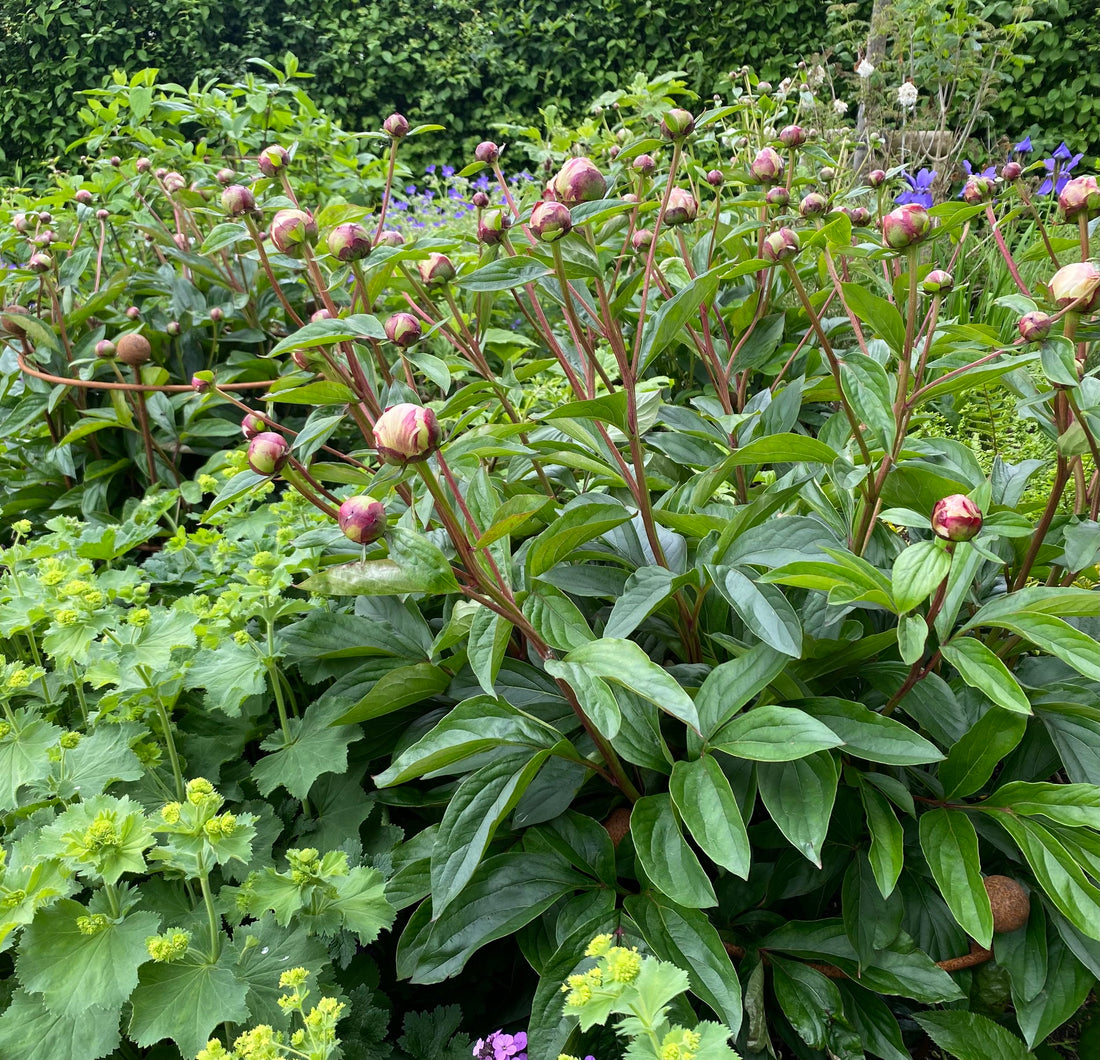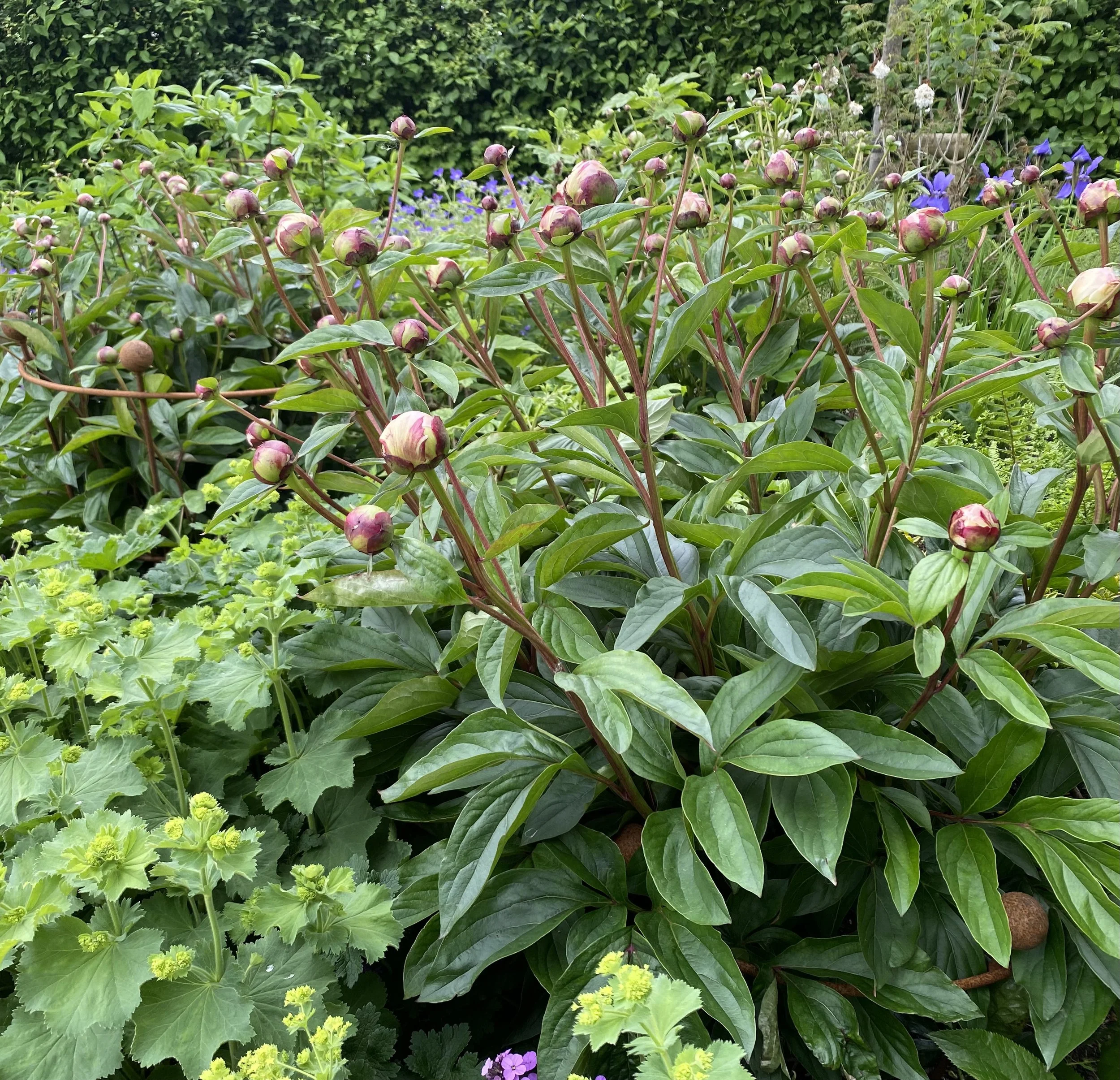
Plants That Need Supporting Now Part 2: Climbers
SEO Space
Peony ‘Kelways Glory’ needs a tall support

Runner beans twine happily around the rusted supports

A cascade of rose and clematis on a tall obelisk
The heavy, heavy rain
The heavy, heavy rain of mid-June, I suspect, has found us all out! I thought that my peonies were well supported and was sure that most of the big herbaceous clumps had enough semi-circular supports around them to keep them out of harm’s way, but a British summer will soon test our confidence! Three days before the rain, the peonies were in full ballet-dancer bloom. After a day of heavy rain the flower heads were bowed.
In my haste to get everything supported, I had put a regular peony support onto this Paeonia lactiflora ‘Kelways Glory’ (probably the largest double white grown), knowing that it will grow to 1.5m. Its neighbour, which has a tall peony support, still holds its heavy heads high. It’s something I always discuss with clients, ensuring that the support is the right height for the plant, and then I made the error myself!
So, even more reason to get supports onto the climbers in good time to stop them collapsing. But what will you need?
Obelisks
The choice of obelisk depends, in part, on what you want to support and, also, on the design of your garden. There is no rule that says these are for roses and those for runner beans. I can only make a few suggestions that I hope will help.
Our obelisks come in two or three sizes and can be mixed and matched in the border. They will give strong support to the growing plant, provide architectural structure in winter and, above all, will not collapse when the full growth of the plant is weighed down by flowers and rain.
Circular & Square Obelisks give light and airy support for delicate roses and clematis which can spill out of the top in profusion; self-twining plants seem to team naturally with the rusted patina of the supports which gives them ‘bite’ as they twine up the legs.
Cotswold Obelisk …sweet peas will always grow taller than you anticipate, even if they are pinched out to make more bushy growth. A wigwam of long willow branches looks lovely but will only last a couple of years. I grow mine up a 200cm Cotswold Obelisk where they self-twine happily and always reach the top before the end of the season.

A short Square Obelisk in a container supports clematis on the Alitex stand at RHS Chelsea

Clematis ‘The President’ flowers profusely on its tall Abinger Obelisk

Climbing rose ‘Tea Clipper’ has responded well to lateral training

Even in winter an Abinger Obelisk makes a statement

Sweet peas are self-clinging on a Cotswold Obelisk

Rosa ‘Gertrude Jekyll tumbles over the top of a Clematis & Rose Obelisk
Abinger Obelisks I think Abinger obelisks are the most architectural of our designs; the same obelisk supports a freely-flowering clematis in the summer border and gives height and definition to the snowy, winter border.
Clematis & Rose Obelisks and Cages I share with the late David Austin my love of Rosa ‘Gertrude Jekyll’. She has everything: strength, scent, wonderful colour, a long flowering period, few thorns and can be trained as a short or medium climbing rose. Her heavy heads look sumptuous spilling out of this clematis & rose obelisk which we originally designed to contain a rampant Rosa ‘Canary Bird’ – another rose that benefits from space at the top to spill over.

In early spring, the Clematis & Rose Cages and Lobster Pots give height and focus to the border

In the garden of one of my favourite designers, Juliet McKelvey has used an Abinger Arch to train a hornbeam hedge

B Brooks has made a scented link between one garden room and the next using an Abinger Tunnel
What could be more romantic than a tunnel covered with roses and clematis leading from one garden room into the next
On a more practical level, I love this hornbeam hedge trained round an Abinger Arch – it gives a strong structure to prune to and shapes the vista behind perfectly.
Our trellises are all made to measure and can be entirely wall mounted or the legs can be sunk into the ground and the frame simply tied back to the wall for vertical support without the need to bear the weight of the trellis and plants.
Where it is not possible to give the support stability by fastening it to a wall or other structure, we offer espaliers – either straight or curved – that are supported by their own legs discretely welded to the back of the espalier. We are training apples on ours, underplanted with alliums and ammi majus, but it would look glorious with a wall of roses and clematis covering it!

Rosa ‘Bobby James’ is growing strongly up a trellis fitted to a shed wall

Our newly established apple espalier will provide both interest and shelter alongside our outdoor sitting area

Broad beans, planted in October, are now ready for picking – a broad bean support keeps the plants upright and makes it easy to see the pods
Finally …
There is one thing on which I differ from my much-respected and admired botanical painting teacher, Anne-Marie Evans, (at this point I can hear a collective intake of breath from hundreds of botanical painters who wonder what I can possibly be about to suggest!). Well, the answer is broad beans!!
Anne-Marie, with her French heritage, always said that she was horrified by the English who ate tough beans with their skins on, while the French de-podded, cooked and then skinned the beans and ate the soft, interior beans. If, as we do, you pick the beans when they are tiny (barely showing their shapes within the pods); blanch them for 60 seconds in boiling water and eat them as a special garnish, then they are the most delicious vegetable you can imagine and there is no need to slip off the bean skins because they are as delicate as the beans themselves.
I hope I have given you a few ideas for using height in the garden. It gives an additional dimension: one that even the smallest garden will benefit from.
Follow us on Pinterest for more advice and inspiration for your English country garden: www.pinterest.co.uk/plantsupports
Follow us on Instagram: www.instagram.com/muntons_plant_supports
Follow us on Facebook: https://www.facebook.com/muntonstraditionalplantsupports
